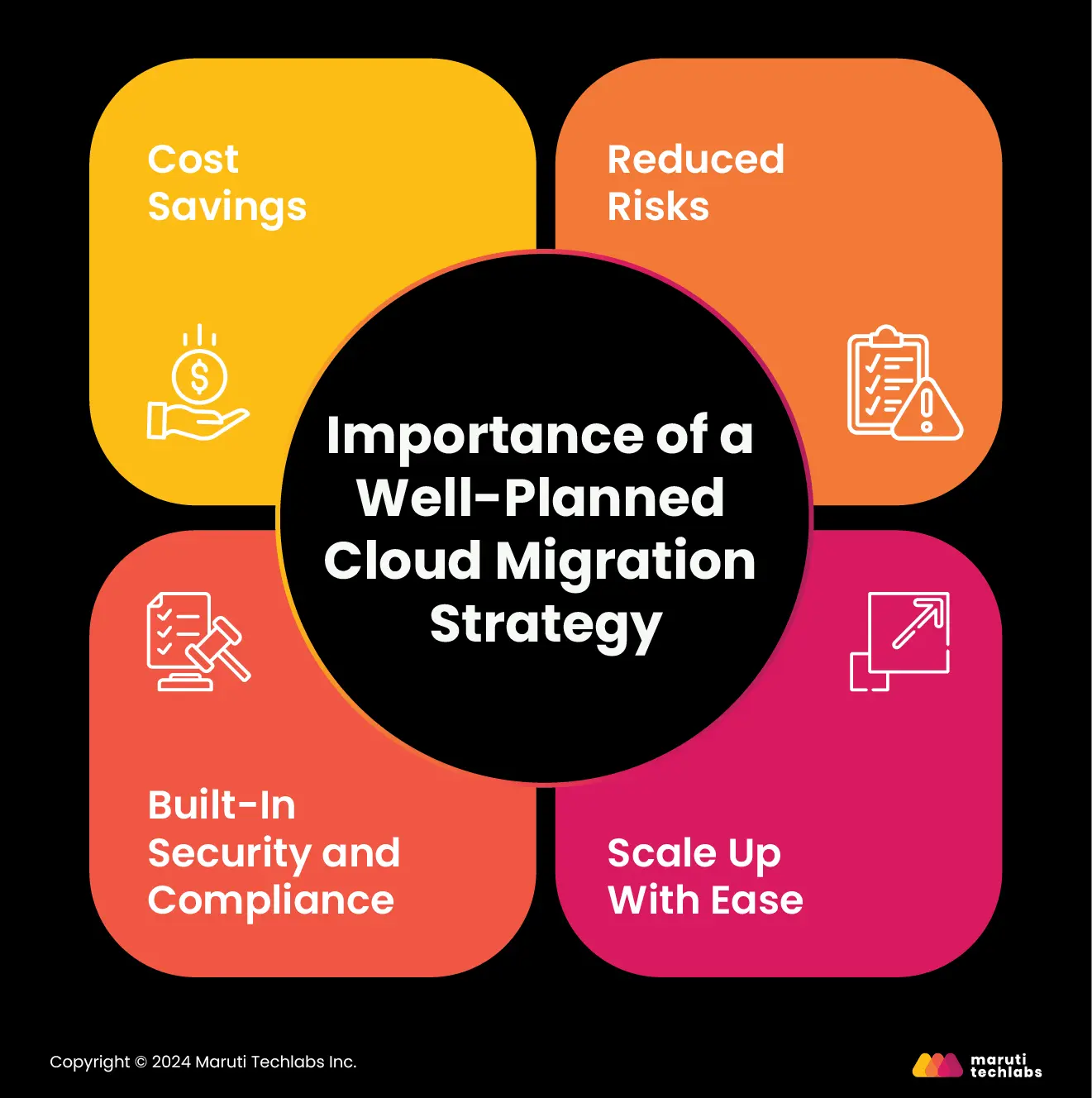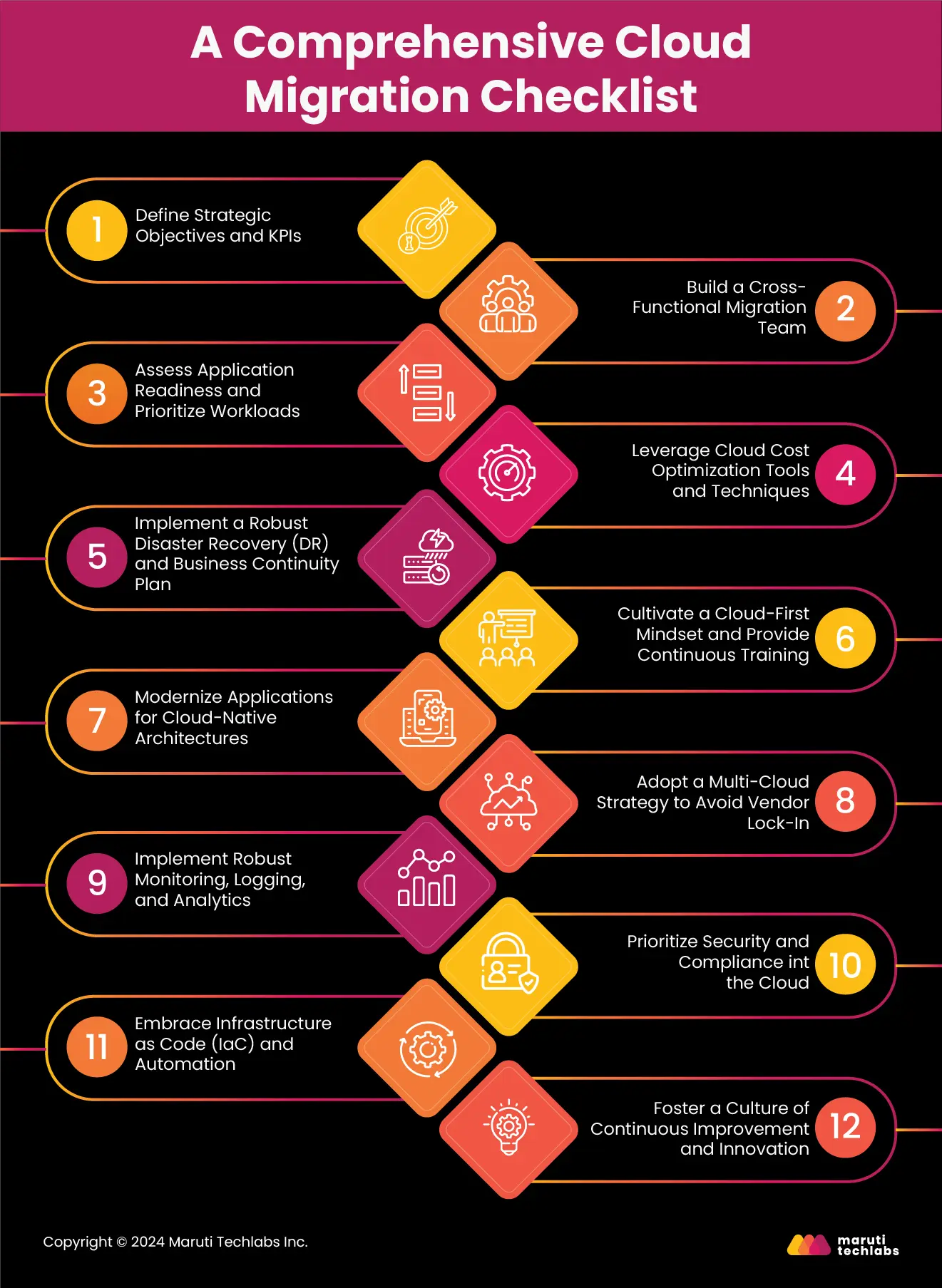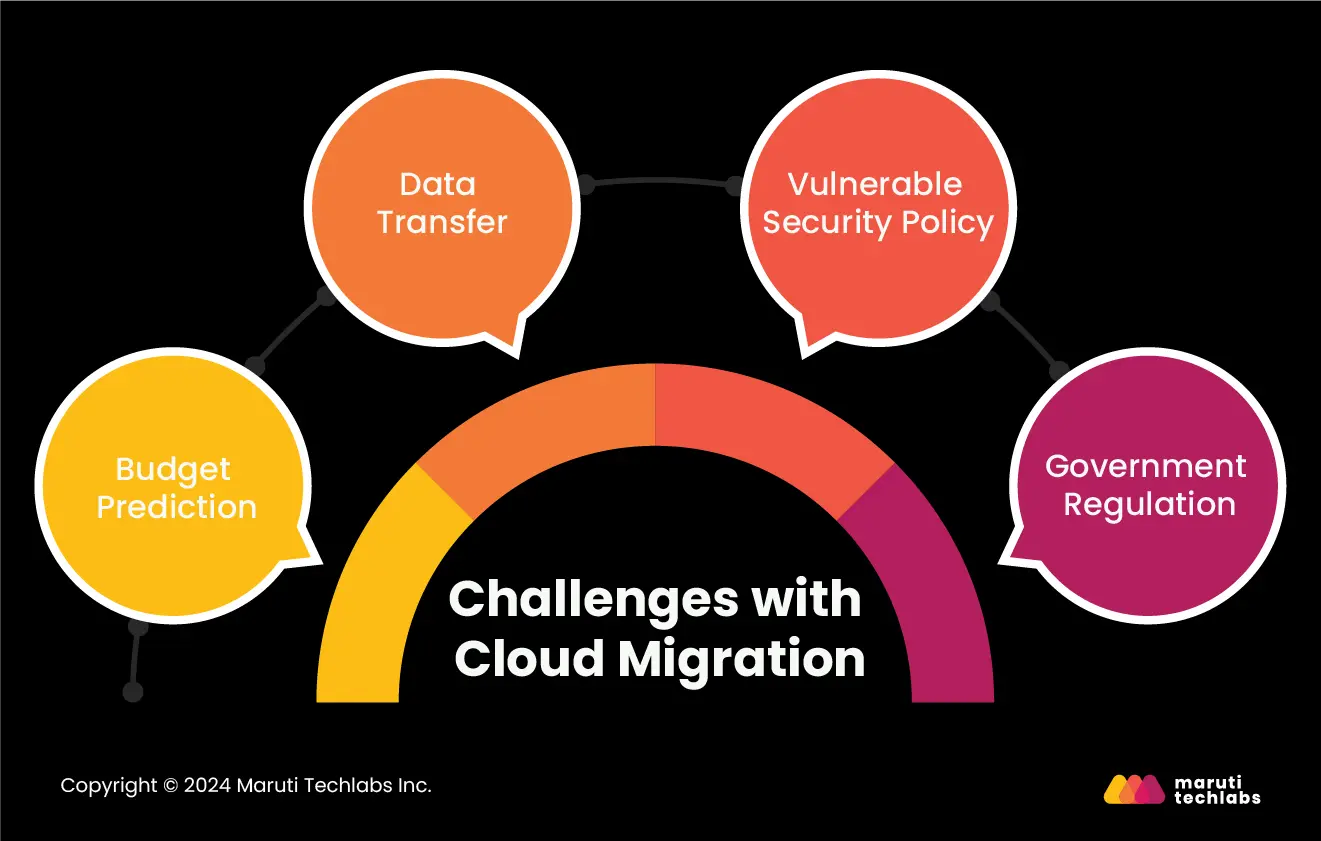

The Complete Guide to Successful Cloud Migration: Strategies and Best Practices






The expanding network of connected devices has fueled a massive surge in data creation. Businesses are turning to cloud migration services to address the growing need for affordable storage solutions. Research conducted by Gartner analysts indicates that by 2025, 85% of companies are projected to adopt a cloud-first approach.
However, migrating to the cloud is no simple task. Only 3 out of 10 organizations know exactly where their cloud costs are going. You need the right migration strategy for your IT assets and planning accordingly.
A cloud migration strategy helps transition an organization’s applications, data, and infrastructure to the cloud. It ensures a smooth, successful migration by identifying key applications, assessing modernization approaches, and outlining steps to achieve better scalability, performance, security, and reliability. With the right guidance and expertise, businesses can leverage cloud migration to optimize operations, innovate, and achieve sustainable growth.
This article aims to provide a comprehensive understanding of cloud migration strategies, helping you create a roadmap for migration and transition smoothly to the cloud.
Let’s start by exploring what a cloud migration strategy means.
A cloud migration strategy is a blueprint for organizations to transfer their current infrastructure, including data, applications, and services, to cloud-based platforms. The transition offers many benefits, including reduced IT costs, enhanced business agility, improved security, elimination of end-of-life concerns, data center consolidation, facilitation of digital transformation, accelerated growth, and access to new technologies.
However, since each organization's journey to the cloud is unique, there's no one-size-fits-all approach. Every IT asset possesses distinct cost, performance, and complexity characteristics. Moreover, certain workloads may not be suitable for migration.
To address these challenges, organizations develop migration roadmaps called cloud migration strategies.
Commonly referred to as the 6 R's of migration, these strategies offer solutions for migrating IT assets to the cloud.
Cloud migration provides many benefits (and is not limited to) —global scalability, enhanced security, and a competitive edge. Here are some of the reasons to modernize your operations:

Adopting cloud migration strategies helps avoid common pitfalls such as cost overruns, downtime, data loss, resource misallocation, and vendor lock-in. You can simplify and streamline the migration process and achieve benefits such as:

Here is a comprehensive approach to creating a successful migration plan. It covers all business areas essential for migration, from people to technology, governance, and operations.
Ensure that your cloud migration goals align with your overall business goals to ensure the migration strategy provides meaningful value to the organization.
Establish a high-level connection between migration goals and business priorities using a structure such as the Balanced Scorecard or Objectives and Key Results.
Collaborate with key stakeholders to develop SMART KPIs to assess the success of your migration efforts at various stages of your journey. These might encompass cost reduction, application performance, user adoption, and business agility indicators.
Leverage tools such as Klipfolio, Tableau, or PowerBI to visually represent these KPIs and share them with various groups in the organization.
Review and adapt KPIs regularly as your business objectives change to support your organization.
Set up a cross-functional team that involves representatives from various business units, such as IT, operations, security, and relevant departments. This ensures you consider different perspectives and requirements throughout the migration process.
Ensure the team has the necessary skills (DevOps, cloud) and expertise, including cloud architects, developers, data specialists, and subject matter experts.
If you need more in-house expertise, consider hiring external consultants or partnering with a managed service provider to fill any skill gaps and provide guidance. You might also invest in in-house training programs to hone your developers’ skills.
Before you start your cloud migration, evaluate whether your application is ready. Consider factors such as assessment of dependencies, performance requirements, cloud compatibility, and the benefits of moving to the cloud.
Tools such as AWS Migration Evaluator, Azure Migrate, and Google Cloud Migrate for Compute, among others, can be used to automate discovery and assessment, which provides deeper insights into the application landscape. Moreover, applications should be prioritized based on criticality, complexity, and importance to the business.
Before that, use the 7 Rs framework for each application's most suitable migration strategy, ranging from Rehost, Relocate, Replatform, Repurchase, Refactor, Retire, and Retain to cost, effort, and aspiration. In addition, technical debt should be noticed.
Note: The assessment phase lays the foundation for a well-informed and targeted migration plan.
Proactively manage and optimize cloud costs to ensure migration brings expected financial benefits.
Use native cost management tools the cloud issuer provides, such as AWS Copy Explorer, Azure cost management, or Google Cloud Billing, to leverage resource usage and spending patterns. These tools help you track costs, expose outstanding costs, and receive optimization recommendations.
Additionally, use cost optimization technologies like right-sizing instances, user-reserved instances, or budgets and configure auto-scaling mechanisms to reduce resource costs significantly.
Use 3rd party tools such as CloudHealth, Cloudability, or Densify to get more insights and automation capabilities to get multi-cloud cost optimization and governance.
Establish cost allocation tags, budgets, and alerts to control cloud spending and make data-driven resource allocation and optimization decisions.
Ensure the resilience and availability of applications in the cloud by using cloud-native DR services, including AWS Elastic Disaster Recovery, Azure Site Recovery, or Google Cloud Disaster Recovery for easy and automated replication and failover of workloads to secondary locations.
In addition, design DR architecture that fits your business needs based on recovery time objectives, recovery point objectives, and data consistency.
A multi-region or multi-cloud strategy can be implemented to improve resilience by dispersing workloads throughout various geographic areas while minimizing the impact of any one vendor’s lock-in.
Furthermore, utilize frameworks such as NIST SP 800-34 or ISO 22301 for DR planning, testing, and continuous improvement.
Even if your application is ready for the cloud, your team might not be. Hence, promote the adoption of cloud-native technologies and practices. Conduct surveys while providing comprehensive training and certification programs to equip employees with the necessary skills and knowledge to operate effectively in the cloud environment.
Leverage cloud providers' extensive training resources, such as AWS Skill Builder, Microsoft Learn, Google Cloud Training, or Pluralsight, which provide role-based learning paths and hands-on labs.
Encourage the adoption of cloud-native architectures, such as serverless computing, containers, and microservices, to take full advantage of the cloud's scalability, agility, and innovation capabilities.
First, divide your monolithic applications into smaller and loosely connected microservices. This can be done using domain-driven design principles.
To deploy and manage microservices, you need scalable and portable runtime environments. Thus, use containers and orchestration platforms like Kubernetes, Azure Kubernetes Service, Google Kubernetes Engine, or AWS ECS/EKS.
Another option is serverless computing. For example, AWS Lambda, Azure Functions, or Google Cloud Functions enable event-driven architectures that auto-scale with incoming traffic. Hence, you don’t have to worry about the underlying infrastructure management.
To optimize your software development life cycle, apply CI/CD pipelines, such as Jenkins, GitLab CI/CD, CircleCI, or AWS CodePipeline.
Assess cloud providers' strengths and weaknesses and get services most appropriate for specific workloads. Compare their individual peculiarities, pricing models, and geographic spread.
To avoid relying on closed services, use infrastructure provisioning, application deployment across several clouds, or configuration management with tools like Docker, Vagrant, Ansible, or Kubernetes.
Evaluate how your current cloud providers perform regarding cost efficiency and innovation, using your developing business strategies to modify the multi-cloud approach whenever necessary.
Have centralized monitoring approaches like AWS CloudWatch, Azure Monitor, Google Cloud Monitoring, or third-party solutions such as Datadog to provide real-time insights into the behavior and performance of cloud resources.
Use log aggregation/analysis tools like Splunk, ElasticSearch ELK Stack (Elasticsearch, Logstash, Kibana), Sumo Logic, or Loggly to collect log data from different sources for troubleshooting purposes and identification of irregularities while making reports on adherence.
Set alerts and notifications based on predetermined thresholds to detect oncoming problems with end users.
To gain a much quicker root cause analysis and optimization, use distributed tracing tools, like AWS X-Ray, Azure Application Insights, or Google Cloud Trace.
Use the shared responsibility model to explain your organization’s security obligations as opposed to those of a cloud provider. Prevent unauthorized access to resources using IAM, encryption, network security groups, and WAFs.
Moreover, follow the best practices like implementing least privileged access, MFA, and regular security audits.
In addition, to avoid financial penalties, follow appropriate regulations and standards, such as GDPR, HIPAA, SOC 2, etc.
Use tools from third-party vendors or public cloud providers to maintain an ongoing compliance state with automation for compliance posture assessments.
Document infrastructure details as code templates using equipment like Terraform, AWS CloudFormation, Azure Resource Manager, or Google Cloud Deployment Manager. This permits reusing the templates and preserving matters steadily throughout exceptional environments.
Use configuration control tools like Ansible, Puppet, Chef, or SaltStack to deploy applications and servers mechanically. This standardizes the setup technique and reduces manual mistakes.
Use automatic testing techniques like Selenium, Cucumber, or Postman to ensure the utility works successfully before deploying it.
Create serverless programs with AWS SAM, Azure Functions Core Tools, or Google Cloud Functions Framework.
Implement DevOps practices, such as CI/CD and infrastructure as code (IaC); explore cloud-native services, like machine learning, big data analytics, and IoT.
Regularly review and update your cloud migration strategy based on lessons learned, technology advancements, and evolving business needs.
Encourage knowledge sharing, collaboration, and feedback loops across teams to identify improvement opportunities and foster a culture of excellence in the cloud.

Even if your cloud migration plan is in action, you may encounter challenges, including technical complexities, organizational resistance, and regulatory hurdles.
But by taking proactive measures, you can effectively overcome them.
While a cloud migration strategy guarantees long-term cost savings, accurately predicting the budget can be a full-size mission.
Cloud migration involves fluctuating computing resources and storage intake, often leading to underestimated costs. Unanticipated costs can also arise from data transfer fees, increased resource utilization, or additional services required during the migration.
Thus, effective cloud migration strategies must include detailed financial planning and continuous monitoring to avoid budget overruns.
Transferring vast amounts of data to the cloud can be time-consuming and complex.
The cloud migration workflow should account for the bandwidth limitations, potential downtime, and the physical logistics of transferring large datasets.
Some providers offer services to physically copy data onto hardware and ship it, which can expedite the cloud data migration strategy. However, ensuring data integrity and minimizing transfer time remain the major hurdles.
Security is one of the primary issues during cloud migration.
Despite the security measures provided by cloud vendors, you should implement your robust security policies. This could include managing access and admin rights, providing employees the minimum necessary permissions, and restricting access to defined IP addresses.
Each country has stringent laws governing data privacy and storage, such as the GDPR in Europe.
So, understand these legal obligations and choose cloud migration solutions that comply with all relevant laws. Political factors and international relations can also impact data storage rules, adding another layer of complexity to your enterprise cloud migration strategy.
Cloud migration offers cost savings, improved scalability, enhanced security, and greater flexibility. These benefits are best realized with a strategic approach that sets the foundation for a successful transition. Executing it can be complex and challenging due to the technicalities involved.
Consider partnering with Maruti Techlabs, your experienced cloud migration expert, to ensure a seamless transition. Our cloud migration services help businesses optimize their operations and leverage the full potential of cloud computing for enhanced scalability, flexibility, and efficiency. From selecting the right platform to creating the structured framework and executing the plan, we provide guidance, best practices, and hands-on support throughout the migration process.
Connect with us and get started with your Cloud migration journey. To estimate your migration budget and ROI before you begin, try our Cloud Migration Cost Calculator — a quick way to understand potential savings and plan your transition effectively.
Cloud migration means moving an organization's data, applications, and IT processes from on-premises infrastructure to cloud-based services.
A cloud-first strategy prioritizes cloud-based solutions over traditional on-premises infrastructure. It involves assessing if each IT project can be done using cloud services and using them as the main option.
Cloud migration usually includes assessing current systems, selecting the right cloud services, planning the migration, executing it, and improving the cloud system post-migration.
The four phases are assessment (checking what you have), planning (deciding what to move), migration (moving workloads), and optimization (making the cloud work well).
The best enterprise cloud migration strategy depends on factors such as existing infrastructure, business goals, and regulatory requirements. Common strategies include lift-and-shift, re-platforming, re-architecting, and hybrid cloud deployments.
To select the right cloud migration services partner, evaluate their expertise, experience, reliability, security measures, cost-effectiveness, and compatibility with your organization's goals and requirements.


